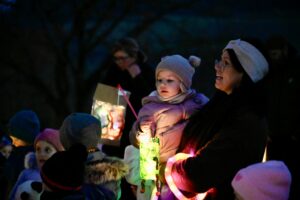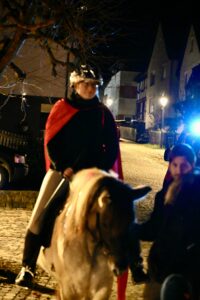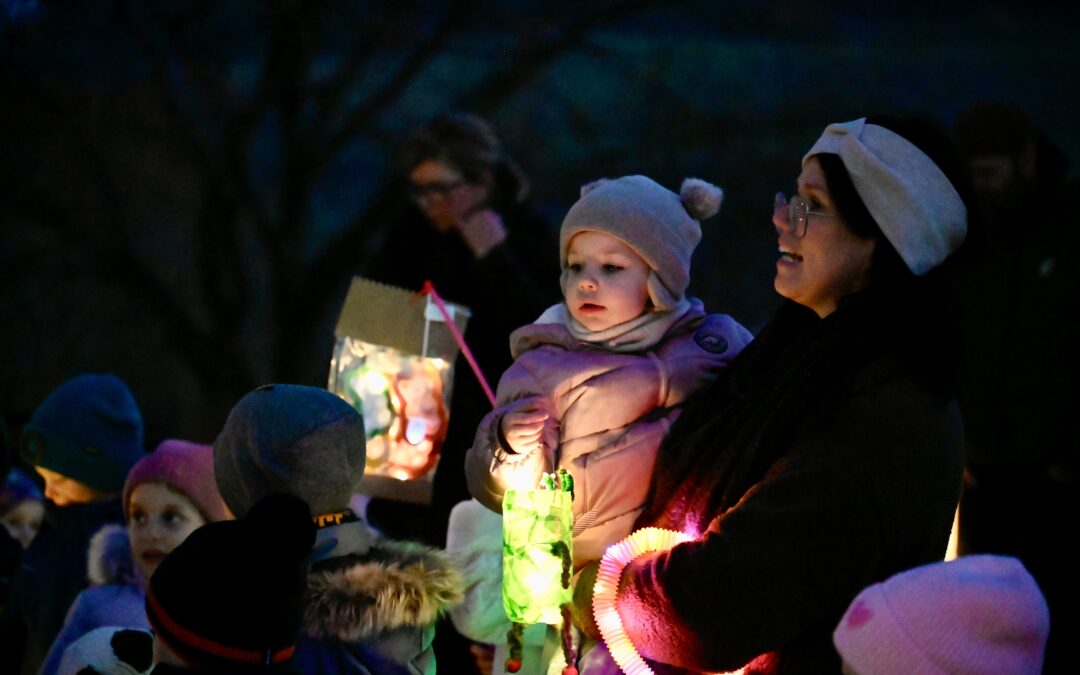 Last night, Ela and I plus three of our kids attended the Martinmas Festival in our little town in Germany. Schwarzenborn is the spitting image of a stereotypical German town – timber frame houses (we would call them Tudor), a central parish church built in the 14th Century, all of which are bracketed by green hills with cattle farms. As I write this, there is a large herd of sheep on one of the hillsides. For Americans like us, words like charming, quaint, and lovely come to mind. But, Martinmas was an order of magnitude more lovely.
Last night, Ela and I plus three of our kids attended the Martinmas Festival in our little town in Germany. Schwarzenborn is the spitting image of a stereotypical German town – timber frame houses (we would call them Tudor), a central parish church built in the 14th Century, all of which are bracketed by green hills with cattle farms. As I write this, there is a large herd of sheep on one of the hillsides. For Americans like us, words like charming, quaint, and lovely come to mind. But, Martinmas was an order of magnitude more lovely.
We were told to gather at the Seniorzentrum, our local retirement home. There, the elders of the community looked out their windows to see the children and parents, all decked out in warm clothes, the children carrying little LED lit lanterns that they had made earlier that day. A hymn was sung, and little mugs of Gluhwein (a hot spiced wine) were passed out – not to the kids of course. Then the procession began, led by a woman dressed as Saint Martin on horseback, complete with red cape. Boys and girls in the auxiliary of the volunteer fire department carried torches. People passed around bottles of beer as we walked up to the parish church. But we didn’t go in. Another song was sung, and then we continued on to the fire station for bratwurst, curry wurst, and pommes – they would never call them French fries here. The commemoration of Saint Martin of Tours is celebration of the very founding of Christianity in Wester Europe. It can be said that no saint had a deeper impact on the flourishing of the Church in these parts than Martin. Saint Augustine of Canterbury’s parish church in Canterbury was dedicated to Saint Martin. Even the word chapel comes from the cape he tore in half, giving half to a poorly clothed and cold beggar by the side of the road, Jesus himself. It is said that pieces of this cape were sent out as relics through this early somewhat Roman, somewhat Gothic set of kingdoms, and as buildings were built around these pieces of Saint Martin’s capel, they became known by that word, in French chapelle and in German kapelle.
 Martin represents a crucial turning point in European history, perhaps more than even Constantine, in which the warrior class of centurions and barbarians is rejected for a new reality: Christians marked by charity. As historian Tom Holland has pointed out, the history of Europe is the story of barbarians tamed by the Gospel. But, it wasn’t just Barbarians. The whole order of Roman power and military might was brought to its knees. Today, we live in that part of Europe which was once the Holy Roman Empire, a land which some might call post-Christian. I happen to think that this term is woefully inadequate, for Europe cannot cease to be Christian in certain overt ways – this little celebration of Martinmas being one of them. The better term is one used by the Dutch missiologist Stefan Paas, who calls it post-secular. Secularism blew through Europe in the 1960’s, affecting not only society, but the Church as well. It became understood that the Church must keep up with the times, must change, must be open to her own secular future. Theologians spoke of the “death of God” and many people began to live in an entirely secular frame. Yet the last seventy years have shown us that this secular “triumph” was pronounced too soon. A revival of Christian faith and practice is sweeping through Europe. Historians are pointing out that Europe’s most deeply-held values: care for the poor, universal medical care, human rights, and equality before the law to name a few, are all Christian in origin. An exclusively secular view has no room for such deeply-held values.
Martin represents a crucial turning point in European history, perhaps more than even Constantine, in which the warrior class of centurions and barbarians is rejected for a new reality: Christians marked by charity. As historian Tom Holland has pointed out, the history of Europe is the story of barbarians tamed by the Gospel. But, it wasn’t just Barbarians. The whole order of Roman power and military might was brought to its knees. Today, we live in that part of Europe which was once the Holy Roman Empire, a land which some might call post-Christian. I happen to think that this term is woefully inadequate, for Europe cannot cease to be Christian in certain overt ways – this little celebration of Martinmas being one of them. The better term is one used by the Dutch missiologist Stefan Paas, who calls it post-secular. Secularism blew through Europe in the 1960’s, affecting not only society, but the Church as well. It became understood that the Church must keep up with the times, must change, must be open to her own secular future. Theologians spoke of the “death of God” and many people began to live in an entirely secular frame. Yet the last seventy years have shown us that this secular “triumph” was pronounced too soon. A revival of Christian faith and practice is sweeping through Europe. Historians are pointing out that Europe’s most deeply-held values: care for the poor, universal medical care, human rights, and equality before the law to name a few, are all Christian in origin. An exclusively secular view has no room for such deeply-held values.
 I would say that cracks in this secular mindset were most visible in Nazi Germany. This brutal regime held to the ideals, not of Christianity, but of social Darwinism, believing that man set free from the chains of the Christian past could fulfill his destiny of becoming a whole new race. For the Nazis, the Christian witness of Saint Martin’s care for the poor was best characterized as weak. Post-war Germany, divided between western capitalist industrialism in the west and Soviet ideology in the east – both, incidentally, forms of secular liberalism, served to isolate people from Christian believing, and quite successfully. Today, less than 3% of the German population is in church on Sundays. Yet, practices remain. Sunday is a day of sabbath rest. It is called Ruhetag – the quiet day. I was in Berlin on a Sunday recently and the quiet on the streets of a city of 4.3 million was terrifying. All grocery stores are closed. Holidays like Martinmas are celebrated with vigor.
I would say that cracks in this secular mindset were most visible in Nazi Germany. This brutal regime held to the ideals, not of Christianity, but of social Darwinism, believing that man set free from the chains of the Christian past could fulfill his destiny of becoming a whole new race. For the Nazis, the Christian witness of Saint Martin’s care for the poor was best characterized as weak. Post-war Germany, divided between western capitalist industrialism in the west and Soviet ideology in the east – both, incidentally, forms of secular liberalism, served to isolate people from Christian believing, and quite successfully. Today, less than 3% of the German population is in church on Sundays. Yet, practices remain. Sunday is a day of sabbath rest. It is called Ruhetag – the quiet day. I was in Berlin on a Sunday recently and the quiet on the streets of a city of 4.3 million was terrifying. All grocery stores are closed. Holidays like Martinmas are celebrated with vigor.
As I looked around last night, the turnout would have made any church leader brim with excitement. Strollers and little kids everywhere. Mothers and fathers together, laboring for the good of their community. Everyone being so wonderfully kind. This is post-secular Europe. It is Christian in ways, but these ways do not include such essentials as prayer, sacraments, or creeds. This is both the opportunity and the challenge. What I have learned in nearly four months living here is that

